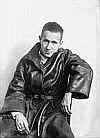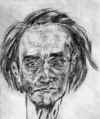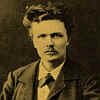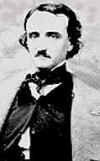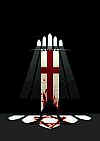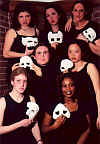|
home
advanced |
Creating
the "Berkovian" Aesthetic Chapter V Visual Elements The visual elements of a Berkovian production are strikingly stark. Classical Greek theatre, Japanese Kabuki, German expressionism, and Vsevelod Meyerhold’s constructivism, [Ref 5-1] are particularly influential on Berkoff’s visual aesthetic. By juxtaposing minimal sets with very theatrical costumes, masks, and lighting, the visual focus is on the actor. Though the costumes draw attention to themselves, they serve to emphasize the performer and help to create the environment and the characterization. Because it is so extreme, his visual aesthetic may appear indulgent, often emphasizing Berkoff’s concept more so than the verbal script itself. In a 1990 interview on Japanese television, Berkoff explains his thoughts on the visual elements in his productions:
Berkoff believes that alleviating his productions from cumbersome sets will help free the audience's imagination. He believes that a representational visual aesthetic is a tranquilizer to the creative imagination of the audience, while his living environment is a stimulant. As he does with other artistic medium, Berkoff chooses specific elements as reference points for his work. Many of the sets of Berkoff’s productions evolve out of the rehearsal process. In the scripts of The Trial and Decadence Berkoff does not list a set designer; likewise, in the original program and script for East, performed at the Royal National Theatre, Berkoff again did not list a set designer. Presumably, the minimal sets for these productions evolved out of the rehearsal process, leaving Berkoff with control over these elements. Berkoff has a keen sense of how to communicate, visually, what he wishes. Although the sets and costumes for other productions are credited to different designers, Berkoff’s repeated monochromatic color schemes, use of formal attire, and overall consistent mise-en-scène reveal that he has a signature aesthetic. The specifics of this aesthetic will be chronicled throughout this chapter. Frustrated by his belief that contemporary theatre fruitlessly attempts to emulate film and television, Berkoff complains that: “Realism can eventually have a deadening effect, since it only mirrors a conscious world and is more suited to TV drama” (Agamemnon 7). Ironically, even though Berkoff attempts to break theatre free of conventional representational aesthetic of film, his own theatre form is idiomatic of movies. He confirms this point in the introduction to his adaptation of Aeschylus’ Agamemnon (published 1977), acknowledging that the ensemble, “worked closer to music and the scenario of film” (7) than traditional realistic theatre in order to develop the production. Similarly, in his introduction to Kvetch (published 1994) he explains: “Scenes should flow easily into each other much as a dissolve in film” (Collected Plays II 45). Additionally, he creates "silent-film" sequences, freeze-frames, and slow-motion effects -- usually elements of a film maker’s arsenal -- which Berkoff uses to enhance theatricality. From the beginning of Berkoff’s career he used these techniques in his playwriting and directing. In his role as playwright Berkoff articulates the performance style with explicit stage-directions. For example, in Metamorphosis, the second stage direction is, “FAMILY dissolve the insect image” (79); and in scene four of The Fall of the House of Usher, Berkoff describes another film-like technique: "Much like film technique we cut from the exterior of the rider to the interior of MADELINE and USHER, and lighting will help and does help to demarcate these differences and separate the time and space" (44-46). As director he explored such techniques to their extreme, leading to his production of Salomé (1988), performed entirely in slow-motion. Berkoff explains that slow-motion works:
These film techniques remain in Berkoff’s theatrical bag-of-tricks as a playwright and director, also evidenced by the slow-motion mimed sword fight in Richard II (1994). Berkoff’s written plays, most published after their initial production, call for these cinematic techniques because Berkoff incorporated them into his overall vision of the play. Black, white, and grays are the primary palette of many Berkovian productions, including Metamorphosis (1969), The Trial (1970), Hamlet (1980), Decadence (1981), Coriolanus (1988), Salomé (1988), and Richard II (1994). Berkoff uses color, like props, sparingly. For these productions, he began the sets and costumes with a monochromatic palette and added colors for effect. Berkoff concludes that color can be distracting: “I like the plainness, the simplicity of black and white. I like the grizzliness, like an old photograph [. . . .] So, I think black and white is more dynamic and colors can interfere unless they have a purpose, a point” (Personal interview). Berkoff’s monochrome productions often produce a visual effect more stunning than one using color. This simple technique often results in an elegant visual aesthetic, which appears to contrast sharply with Berkoff's street-wise persona. In Salomé, for example, Berkoff established a costume palette almost completely monochromatic, minus a few accents, but was still considered as lavish as Wilde’s language. The Financial Times’ reviewer Michael Coveney simply called it “elegantly slow motion, minimally excessive . . .” (Review of Salomé I:25). The phrase “minimally excessive” is a perfect description of much of Berkoff’s work -- pushing the boundaries of his minimalist aesthetic to the extreme. Berkoff’s aesthetic alludes to the black and white cinematography of early twentieth century film -- noteworthy because other components of Berkoff’s aesthetic also refer to this period: he costumed Hamlet, Salomé, Coriolanus, and Richard II (all mainly monochrome), from the 1920s and 1930s;
George Dillon personally assessed his interpretation of Berkoff's reference to this period: The 20s and 30s were the last decades in which theatre mattered as a "popular" form of entertainment, and they were a time when even mainstream Hollywood cinema was infused with artistic aspiration, mainly through the influx of eastern Europeans bringing theatrical techniques to the film set. It makes perfect sense for Steven to constantly echo these roots. (e-mail correspondence, 11 October 2000) Scenic minimalism, one of the fundamental traits of the Berkovian, selectively restricts furniture, set, and properties to what is essential. The Kafka plays each had one specific set piece that remained on stage throughout the production to anchor all of the other elements. In the Penal Colony (1968) was void of any scenery beyond chairs and the ominous “harrow” that remained on stage throughout. The machine, as described in the story, inscribes the prisoner's crime onto his body. Berkoff commissioned an architect, Alistair Merry, to build the instrument of torture precisely as Kafka describes it in the story. Metamorphosis’ (1969) metal jungle-gym set, originally designed by architect Martin Beaton, is foremost a functional structure. Reminiscent of Meyerhold’s theatre (who worked at the time of Kafka), Metamorphosis’ set had mechanistic scaffolding and ramps. Coupled with imaginative lighting (designed by Berkoff), Berkoff creates the ever present image of a bug caught in a prison cell. The harrow and the jungle-gym structure are evidence of Berkoff's approach to setting. Instead of traditional set designers, he took a more practical approach by hiring architects -- assuring himself of functional and artistic structures. Moveable door frames became the central element in The Trial (1970); Kafka’s tale of a bank clerk, Joseph K., who is arrested but charged with no crime. He waits endlessly for due process, but he is never summoned forward. In the novel, Joseph K. moves from location to location in search of relief from his arrest. In Berkoff's adaptation, the world, via the chorus and door frames, shift to accommodate K. Such mobility relieved the production of lumbering set changes because the cast changed the location and mood of the play “as a flash with the magician’s sleight of hand [. . . .] quicker than the story” (Trial 6). This is a Berkoff trademark: his ability to create something complex out of the simplest materials. Berkoff describes the set of The Trial as an element the entire company devised. In The Theatre of Steven Berkoff, he says: “We devised a door” (Berkoff 37). [Ref 5-2] That door evolved into a series of ten doors that the cast manipulated to communicate different locations and psychological environments. Through their choreography, the chorus established the setting:
Just as actors become elements, so do the frames become a chorus that comment on the action by assuming a group dynamic. Berkoff explains that when the London Theatre Group mounts a production, they “search for objects that have no character except when they are being used in direct relation to the actor, when they become charged with life” (Gambit 8). At its most effective, when actors are used as environment, they disappear as the puppeteers in Bunraku and the door frames take on a life of their own. It is a powerful transformation and Berkoff believes makes the chorus completely responsible for the physical and psychological environment: “The chorus was as a Greek chorus, becoming the conscious of K. The care of their playing, the depersonalized attitude of the people, was necessary for K. to view them as a “faceless group moving together” (Trial 6). Even though this set was mobile, as opposed to the stationary harrow and jungle-gym of In the Penal Colony and Metamorphosis respectively, the door frames too remained on stage through the show. Berkoff staged the Kafka plays with as much scenery as just about any play he would direct throughout the early portion of his career. Berkoff increasingly abandoned permanent settings, and, instead, began to use simple wooden chairs (or stools) and tables. In one form or another, Berkoff used this convention in Metamorphosis, The Trial, East, Greek, Hamlet, West, Kvetch, Salomé, Coriolanus, and Richard II. In Kvetch, for example, one table became a bed, an office desk, and a restaurant table. A table anchored the restrictive blocking of Greek, becoming a “mini-stage,” that Berkoff says the actors clung to “like space travellers moored to their craft” (Free Association 341). In The Theatre of Steven Berkoff, Berkoff says of his set for Greek specifically, but also referring to his aesthetic in general: “It was staged simply in the usual stripped-down style I would, for want of a better term, call functionalist” (139). Berkoff is not aligning himself with any movement (beyond his usual anti-realism), but is, instead, indicating that the primary purpose of his sets are practical instead of decorative or representational. The only other extensive set used by Berkoff appeared in the original 1980 production of Greek, consisting of three white panels serving as a backdrop. These panels further depersonalized the set and, in an abstract way, suggested the white-marble architecture and columns of ancient Greece. These panels were not “marbleized” in any way. In the earliest stages of his career, Berkoff adamantly opposed any literal props or set-pieces. At the insistence of the actors in East (1975), he finally relented and used a few real props such as a table, tea pot, and cups (Free Association 19-21). Eventually Berkoff relaxed and laughed at “relying on the ubiquitous chairs that were to become a syndrome of “experimental” theatre” (Free Association 20), a syndrome, of course, that he pioneered. This concession allowed him to realize “you can borrow from all styles without being doctrinaire” (20). Although he loosened his manifesto in later plays, even now, Berkoff half-jokingly says that the minute one sees a sofa on stage, he should flee the theatre (Discussion session, New Haven, CT 6/29/00). In Decadence though, a couch was the central element of the set, which was otherwise limited to a rose, table, [Ref 5-4] and plush throw rug. The couch in Decadence, like the chairs in many other plays, are a foundation for the actors to center their movement. The difference being that Berkoff uses the simplest, wooden chairs in a purely functional way. They do not connote status unless they are contextualized in a specific scene. In one scene the chairs may symbolize thrones while in another they are a neutral environment for the chorus to sit upon, and, in yet another scene, the chairs might suggest a pub. The white, leather couch in Decadence, however, always suggested wealth. Berkoff continued to use a minimal set but he added traditional painted backdrops in Kvetch (1986), the 1988 major revival of Greek, and Brighton Beach Scumbags (1991). This device continued to bridge the gap between his plays and the world outside. The original production of Kvetch in Los Angeles, designed by Don Llewellyn, had “a large painted wall depicting the freeways of Los Angeles as a surreal multi-laned jam of cars” (Theatre of Steven Berkoff 155), which lent an appropriately cartoonish feel to the farce. Brighton Beach Scumbags, designed by Andrew Kay, calls for a more detailed and colorful drop:
For Greek, Berkoff moved from the “white-walled box” (The Theatre of Steven Berkoff 2) of the original production to a drop designed and painted by Gerald Scarfe. Berkoff describes it as “a mass of heads and grimaces, suggesting a football mob or a group of alienated, disenfranchised mortals that stalk the city” (3). However, as usual, Berkoff was concerned that the drop would be too distracting and had it toned down. “The fresco became so fascinating that I was afraid the audience would keep looking at it and not us,” Berkoff confides, “so I carefully lit the stage with overhead and side lights to soften its impact” [emphasis added] (3). The blocking remained anchored to the table and chairs. Berkoff’s attitude toward the set and properties in his filmed work is inconsistent. In 1991, Berkoff wrote a television script (which was never produced), Dahling You Were Mahvellous, requiring actual props like “glasses of all colours” (181), a plate and spoon, mobile phone, filofax, and a bill for the meal. In contrast to the realism of Mahvellous, Berkoff expected West, which he originally wrote for television, to be performed in typical Berkovian fashion; the film version of Decadence (1994) adapted for mainstream theatrical release, remained far outside the realm of realism, though Berkoff did employ an elegant, though minimalist, set. His televised adaptation of Harry’s Christmas -- called Silent Night (1983) -- also used more detailed sets than what appeared in the stage production. By the early 1990s, having gone through various cycles including the monochromatic plays; plays with fixed visual elements; the chair and table plays; and plays with more realistic traits, he no longer relied solely on abstract sets and people as environment, although this was still the principal element in his work. Since Berkoff usually uses props only when absolutely necessary for the plot, the props he does use carry extra weight due to their limited number. For The Fall of the House of Usher (1974), he used only exotic items like a peacock feather to substitute for a pen, and silken fabric to use as a shroud or cocoon. Berkoff emphasizes this concept in his stage directions for Usher: [Ref 5-5]
Currant interprets Berkoff’s direction by saying he “intended both that the tension be sharpened by the reality of priceless objects, and that the nature of the props serve as a manifestation of the protagonists’ brittle mental and physical conditions” (75). Berkoff’s idea of pricelessness in Usher differs from his concept for Salomé (designed by Robert Ballagh) that used “no wine bottles or glasses, nothing that we could not control or change, nothing whose physical laws were subject to gravity, accident, or wilfulness” (qtd. in Currant 75). They ended up using no props, not even a single veil for Salomé’s “Dance of the Seven Veils,” opting instead to mime the action. Berkoff repeated this stance in a 1989 interview with John O'Reilly in The Economist: “I don’t want anything that can be dropped and I don’t want other people’s physical laws to attach themselves to me” (115). This fear of “other people’s physical laws” helps clarify his 1978 conversation with Bruce Elder of Theatre Quarterly, explaining that he wishes to “express something which is inexpressible uncommonly well or in a unique way. I like to take on the impossible because then it makes a demand upon the imagination” (qtd. in Elder 40). Berkoff is fighting against ease. His call for scenic simplicity, is in itself a challenge -- to himself -- to create the impossible, to make something out of nothing. Berkoff premiered Messiah at the 2000 Edinburgh Fringe Festival, and continued his stylistic choice of stunning scenic minimalism. In his rave review for the Scotsman, Mark Brown reinforces this Berkoff trait: Before you hear a single word of the wonderfully muscular script, you are struck by the sheer visual beauty of the play. The Renaissance simplicity of the costumes and set, and the subtlety of the lighting give every scene the exquisite appearance of a Caravaggio painting. (16) Messiah, as usual, received mixed reviews but even the most vitriolic agreed that the staging was beautiful. Fiona Mountford of The Daily Telegraph wrote, "Things start off promisingly enough, with a beautiful back-lit tableau of Christ (Rory Edwards) on the cross, being mourned by Mary." Unfortunately, Mountford concludes that "After this two-hour-plus trip beyond the worlds' worst nightmare, it would have been a joy to watch a staged reading of the yellow pages" (15). To compensate for the minimal set, Berkoff establishes location through acting, text, and lighting. Influenced by Bertolt Brecht, Berkoff used filmed projections in East and Sink the Belgrano! For East, Berkoff projected actual East End images, “commenting and reminding us of the actual world just outside the stage” (Collected Plays I 7), and in Sink the Belgrano!, set designer Ellen Cairns displayed quotations from Prime Minister Margaret Thatcher’s cabinet that contradict the true events of the Falkland Island’s War (as Berkoff perceived them). These devices are indicative of Berkoff’s political agenda, and do not hide his biases.
The patterns on the floor in Hamlet and Richard II are even more abstract than the Kafka plays. Of Hamlet, Berkoff explains:
Always present, the lines define specific space when established with specific movement, and in some cases, lighting. In the 1979 Israeli production of Agamemnon, Berkoff explains the stage “was marked off as a square, the battle likened to a game or contest” (The Theatre of Steven Berkoff 93). Besides the vague imagery, he explains the convention in a more technical, directorial fashion:
The same line represents different corridors, then ignored when not necessary for the immediate action. Light, used in conjunction with the demarcated lines, define the location, time of day, and enhance the stylized movement. The lines may or may not represent a specific physical space just as the actors may or may not be portraying a specific character. The demarcations in Richard II were similarly abstract. Performed on a thrust stage, the floor design was a large circle intersected by a “V” pointing upstage. The most literal stage pattern in Berkoff’s plays was the outline of the submarine in Sink the Belgrano! (1986). Overall, the taped patterns are counterpoint to the lack of traditional set. Although minimalist, this again adds to the sense of fixedness in a Berkovian production because the actors and the major set-pieces (table, chairs, floor markings, the harrow, the jungle-gym structure, etc.) remain on stage throughout. Set changes, usually handled by actors, do not usually occur in darkness nor through invisible machinations. Therefore, the physical environment, though sparse, is constant. The Berkovian costume aesthetic is different for his own plays and those he directs written by other authors. The monochromatic palette and period formal wear are usually imposed on Shakespeare, Wilde, and Kafka while he reserves fairly realistic costumes for his own plays. The costumes are also one of the most vital scenic element because they are usually the most detailed. Whereas his sets and props are spare, the costumes may be opulent. The costumes generally represent the entire environment of a play, not only the individual character. The formal attire of Hamlet (designed by Berkoff), Salomé, and Richard II (designed by Else Ward) communicate the uniform and class of the court yet distance it from the play’s original period. Similarly, the sultry yet ragged costumes of Poe represent the deterioration of the world as well as the characters in Usher and The Tell-Tale Heart. Berkovian costumes fit into two major categories: more realistic costumes dictated by the written texts (East, West, Kvetch, Acapulco, Harry’s Christmas, Dog, Actor); and those more abstract or stylized (Agamemnon, The Fall of the House of Usher, Greek, The Tell-Tale Heart, Sink the Belgrano!, Metamorphosis, The Trial, Hamlet, Coriolanus, Salomé, Richard II). Berkoff’s original plays, mainly the first group, remain in the context of the written text, which usually equate to performance texts because he directed/performed them before they were published. All of the plays in the second group, except for Belgrano, are adaptations or by other playwrights. Berkoff’s interpretation of Kafka’s Metamorphosis demanded that the actor play Gregor “as if a human being locked within the carapace of the beetle” (Gambit 7). Instead of restricting himself to a bug costume, the actor playing Gregor remained in a business suit. This choice diverted focus from the costumes onto the actors. Gregor’s suit was black and white pinstripes, echoing the prison-like imagery of the set and tying this image to the mundane life of a salesman. Though monochromatic, the costumes reflected stereotyped characteristics: the father in a working-class striped shirt and trousers with work boots; Greta wore a simple, youthful dress, and Mrs. Samsa in a matronly dress. As the actor playing Gregor creates the illusion of a bug without donning a bug costume, the actor playing Salomé creates her striptease without taking off her costume. In both cases, the character’s costumes are created through physicality. As Gregor did in Metamorphosis, The Trial’s Joseph K wore a black and white pinstriped business suit, with the rest of the chorus wearing bastardized versions of the same. Men wore combinations of black and white bowlers, blazers, vests, shirts and ties -- but never complete suits -- communicating grotesque images of deterioration. Costumes in the subsequent revivals remained similar, even though they were credited to different designers. Unlike most revivals, Agamemnon’s costumes changed dramatically -- in a sense remaining a “work-in-progress” until Berkoff’s most recent production in 1984. The original costumes, intended to evoke a sense of battle-weariness, were very abstract. They were made of cotton and knitted to look like chain-mail; these then developed into track-suits with American-football shoulder pads to emphasize athleticism, and ended up as simple cotton pants with a classical line and no shirt. Though Berkoff always remains open to subtle change, this dramatic evolution is unique when compared to most of Berkoff’s other revivals. Although most of his adaptations feature a monochromatic environment, and often set in the early twentieth century, his nightmarish productions of Edgar Allan Poe’s The Fall of the House of Usher (1974) and The Tell-Tale Heart (1981) are especially lush and sensual, evoking a nineteenth century Gothic feel. The London Theatre Group constructed sensuous costumes of silk, satin, and lace, and then distressed them, paralleling sensuality with decay. Berkoff demands that the costumes, like the properties for Usher, “be hand made and costly” (The Fall of the House of Usher 42). Berkoff has not published an adaptation of The Tell-Tale Heart, gives it only a passing mention in Free Association, and does not include photos of it in The Theatre of Steven Berkoff, but has recorded the production for television. Currant describes the visual aesthetic, writing The costumes, make-up, and lighting were of a style set somewhere between Noh and expressionism [. . . .] His face [Berkoff's] was whited out, almost ghostly, and his costume was a dark pants over a white shirt. The Tell-Tale Heart was performed totally without scenery or props. (140) Though the costume sounds simple, the shirt had ornate lace fringe, and the style kept a gothic seductiveness consistent with Usher. As Berkoff juxtaposes poetry and vulgarity in his own plays, here he juxtaposes decay with sensuousness. Berkoff moved from the nightmarish decay of Poe into the dreamlike licentiousness of Oscar Wilde’s Salomé. The cast dressed in 1920s formal wear with Berkoff, as Herod, clad in an ornate tuxedo with lavish jewellery. The only exception to the 1920s motif was Jokanaan, sitting downstage center, half-naked. Berkoff’s penchant for juxtaposition is evident by his contrast of the 1920s high society with the biblical martyrdom of Jokanaan. Berkoff does indulge in color and contemporary garb for effect, especially in his own plays. The originals are generally more literal than his other shows. His self-penned productions have a grittiness not present in most of his other shows. Suits, ties, blue jeans, skirts, and casual dresses are typical, but even these clothes are theatrical in contrast to the bare stage. Though more contemporary, East and West’s costumes referred back to The Trial. Dressed in the mock formal attire of the punk-rock late 1970s, Mike and Les resembled a working-class version of The Trial’s chorus -- again a decaying society and, here, a parody of "proper" clothing. Berkoff’s shift from the East End plays to Decadence, his first play to specifically attack the upper class, continued his trend toward stylized yet realistic costuming. In Decadence, two actors portray two characters apiece: one wealthy and one working-class, dressed only in formal wear. Though realistic, the costumes are taken to their absolute extreme: Berkoff in white tie, vest, tails, and over-stuffed handkerchief in a black tuxedo with huge lapels; and, Linda Marlowe, Berkoff’s on-stage foil, dressed in black evening gown, spiked heals, and stockings with garters. Like the characters in Decadence who dress as the quintessential upper-class couple, the actor in Dog dresses as the quintessential suburbanite: “in the mandatory eighties weekend gear: a lurid track suit and what are commonly called ‘trainers,’ a form of jogging shoe.” Berkoff continues, “His guts are sagging over his waistband” (Collected Plays II 221). For Sink the Belgrano!, as in some productions of Agamemnon, Berkoff costumed the chorus in contemporary sweat-suits to again establish athleticism and uniformity. The chorus occasionally added accessories to delineate their characters. The principals dressed in realistic garb -- “Maggot Scratcher” was made to look like Margaret Thatcher and her cabinet wore contemporary business suits.
Agamemnon’s masks, like most other elements of that production, substantially evolved after the première production. In the 1973 production, the entire cast wore stylized make-up, which, as in Greek, partially allude to the masks used in ancient Greek theatre. As the production evolved, dependence on the masks declined. Berkoff acknowledges that “during the Round House performances in 1973, we experimented with 'effects' of all kinds” (The Theatre of Steven Berkoff 78). Eventually, as the costumes were simplified, the chorus abandoned their extreme make-up altogether. During the more experimental period, they added traditional masks to their make-up to emphasize specific images -- the most extreme resembled highly-stylized horse heads, to compliment the mimed horse-back motion of the soldiers returning from battle. By the time they mounted the all-black version of Agamemnon in 1994, the chorus wore no masks. [Ref 5-7] The Tell-Tale Heart, The Fall of the House of Usher, and Salomé emphasized severe make-up to comment upon the pretense of the characters. In Salomé, all of the characters, except Salomé and Jokanaan, wore heavy, Kabuki-style white make-up, accented with ruby red lips. Berkoff explained on Japanese television how his masks connect to visual art:
By depicting Salomé and Jokanaan without make-up, they remain engaged in their own conflict, outside the licentious court. In Richard II, Berkoff continued manipulating focus through mask-like make-up. Contrary to The Trial and Salomé, the protagonist, Richard II, is made-up and the rest of the court is left natural. His hair flaming orange, Richard’s powdered face and pale make-up (plus the accentuated lips and eyes) presented a cross between a fop and a devil. Shakespeare’s Richard II, often portrayed as a weak monarch and man, is here depicted as a tragic hero capable of catharsis. The actor/character’s sweat smears the make-up -- intentionally or not -- as the character loses his pretense. Everyone in The Fall of the House of Usher wore extremely stylized make-up, and all four actors in Greek appeared in white face. From the start of the play, Greek’s cast were frozen as statues, staring downstage. Berkoff eventually established them as a family transfixed on a television, meaning to bridge the gap between the statues of the ancients and those of today. Functionally, the make-up created malleable, animated effects, meant to emphasize the actor’s expressions. The accentuated facial features in Greek helped to compensate for the minimal movement, a departure from the grand physical gestures of Berkoff’s previous work. Unlike The Trial, Greek’s make-up establishes a point-of-view specifically created for the audience. In The Trial the audience watched the action through the eyes of the protagonist -- in the first person; in Greek the audience were further distanced, watching the action in the third person. In Meditations on Metamorphosis, Berkoff described his philosophy, and evolution, of masks:
Berkoff used masks/make-up to create eerie effects for The Fall of the House of Usher to emphasize the gaunt, skeletal features of the Ushers; his techniques walk a fine line between “special effect” and masks. The masks transcended the natural world into the supernatural, assisting the actors to portray humans and objects -- intertwined physically and spiritually. The masks create a oneness between the Ushers and their environment, never allowing the audience to forget the relationship of the Ushers to each other and to their condition; or, as Berkoff explains: “the actor playing USHER becomes vocally and physically a mimetic reflection of the house [. . . .] he is the total mirror image of the house -- the split in the facade no less parallels his own splitting psyche” (The Fall of the House of Usher 44). The character of the “friend,” summoned to the house, experiences the phantasmagoric environment with the audience. When the actor portraying the friend assumes the role of Edgar, the servant, he wore a traditional mask that hid the top of his face. Here, according to Berkoff, the mask’s function is simply “anonymity” (The Fall of the House of Usher 42). The Berkovian use of the mask is a contradiction, meant to dehumanize while accentuating character. Layered in meaning, they create anonymity. The actor then establishes a character, and then transforms again into another. The actor must be the entire environment and none at all, at once exaggerating features and hiding humanity. Make-up has been Berkoff’s most effective technique for masking, since physical and vocal expression, is a major part of his aesthetic.
He also creates a commonality when the chorus members wear masks. They form a grotesque backdrop as a contrast to the rest of the characters. Joseph K. contrasts with the made-up chorus; Salomé and Jokanaan contrast with the court; and Gregor contrasts with the family. The masks then emphasize physical features, while, creating a cohesiveness amongst the cast. In other instances, the masks help to create mood and comment upon the character’s state-of-mind or spirit. This is especially true in the Poe adaptations, where the characters are deteriorating from the inside out. Since Berkoff tours his productions to different types of venue, all technical requirements, including lighting, must remain flexible. This may appear to be an inconvenience, but he views it as an opportunity rather than an obstacle:
In his early shows, lighting was a huge consideration, especially Metamorphosis. Berkoff takes the credit for the original lighting design for Metamorphosis, and its subsequent productions. In Meditations on Metamorphosis, Berkoff explains his disdain for designers: The lighting "designer" wishes to impose his idea on to it but these cannot begin to compare with what has been accumulated over ten productions and trial and error, the gradual building and elimination of waste, the streamlining and then the discovery that all the best ideas come by accident. It was a quirk of fate that since originally we did not know what to put behind the set we just left it as a cyclorama. (121) His attitude toward technicians is so dubious that he insists on flying in his own group for his productions of Metamorphosis (119). The program for Berkoff's 1989 New York production of Metamorphosis lists no lighting designer, only a lighting "supervisor." Berkoff acknowledges that at one time he was very concerned with elaborate lighting design, but, as he matured, lighting became less of a factor:
Berkoff’s lighting serves the purposes of all his visual elements: to create environment, define character and establish mood. As discussed earlier, Berkoff will combine lights with other visual elements, such as the floor patterns, to reach these objectives. Spotlights, strobes, and projections are also part of Berkoff’s lighting arsenal. Mostly though, the lights complement and clarify movement and direct focus when necessary. Although his lighting seems dynamic, ultimately he uses the simplest techniques. As with all elements, Berkoff integrates lighting into his mise-en-scène, to create “total theatre.” Berkoff often uses richly-colored lights in lieu of colored costumes and set. In Salomé, a projected glowing moon floated in a purple sky while Jokanaan sat isolated in a yellow square of light serving as the cistern that imprisons him. The specificity of Jokanaan’s cell, contrasts with the ethereal expanse of Herod’s balcony; the former implying a specific location while the latter creates general mood. The cell is an important image in many of Berkoff’s productions which he communicates through lights. In Richard II’s final moments, he is confined him to a prison cell composed of light. As Berkoff alluded to, Metamorphosis took great advantage of lighting design. Berkoff explains:
In addition, the lights focused on the structure created stark, looming, shadows on the cyclorama. The image of a cell, or prison, was again reinforced. Because Berkoff’s theatre is so actor-centered, the external visual elements, though dynamic, are expendable. One of Berkoff’s greatest accomplishments is that most of his productions can be performed with nothing more than an actor and an acting space; in other words, most of his productions can be produced with nothing at all. This is of course Berkoff’s point, but Berkoff does take great advantage of those visual elements he does use. When most effective though, the performer and the visual elements are as one.
© Craig Rosen 2000 |
